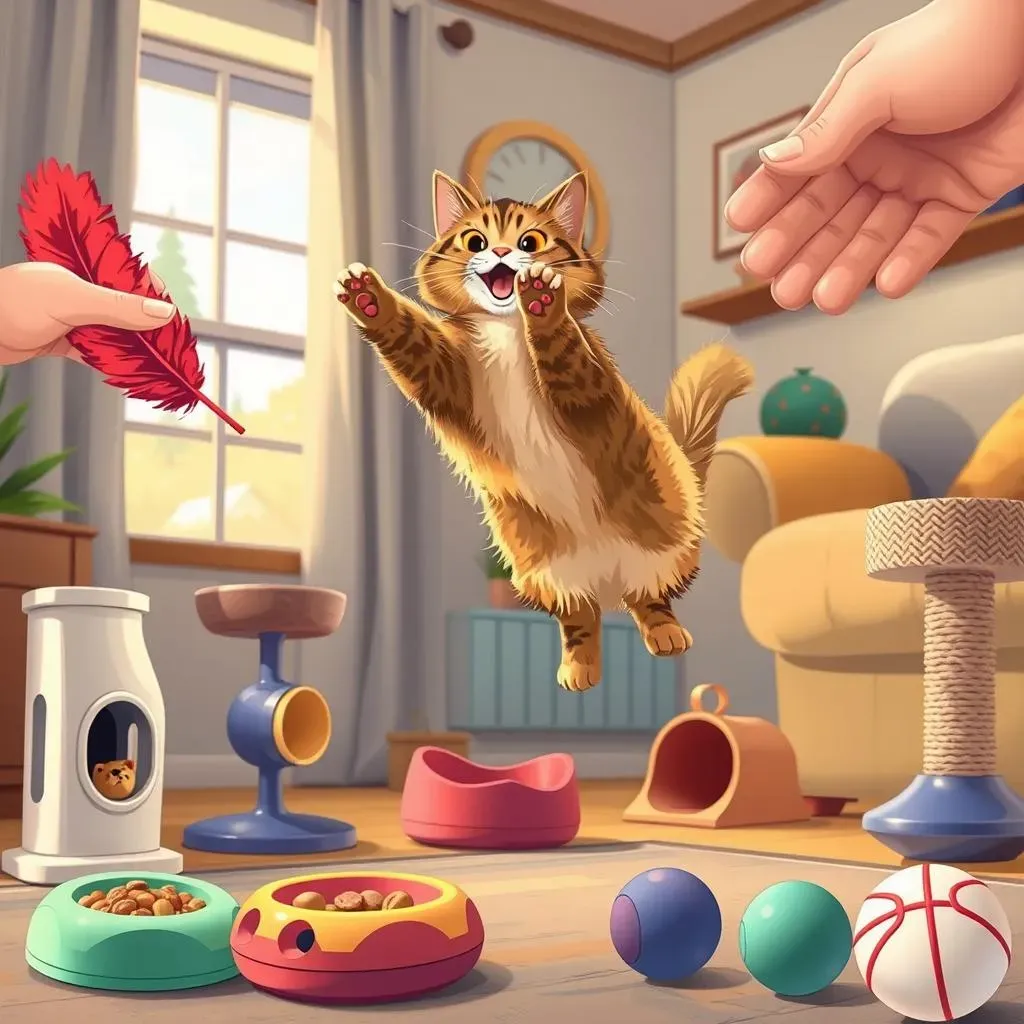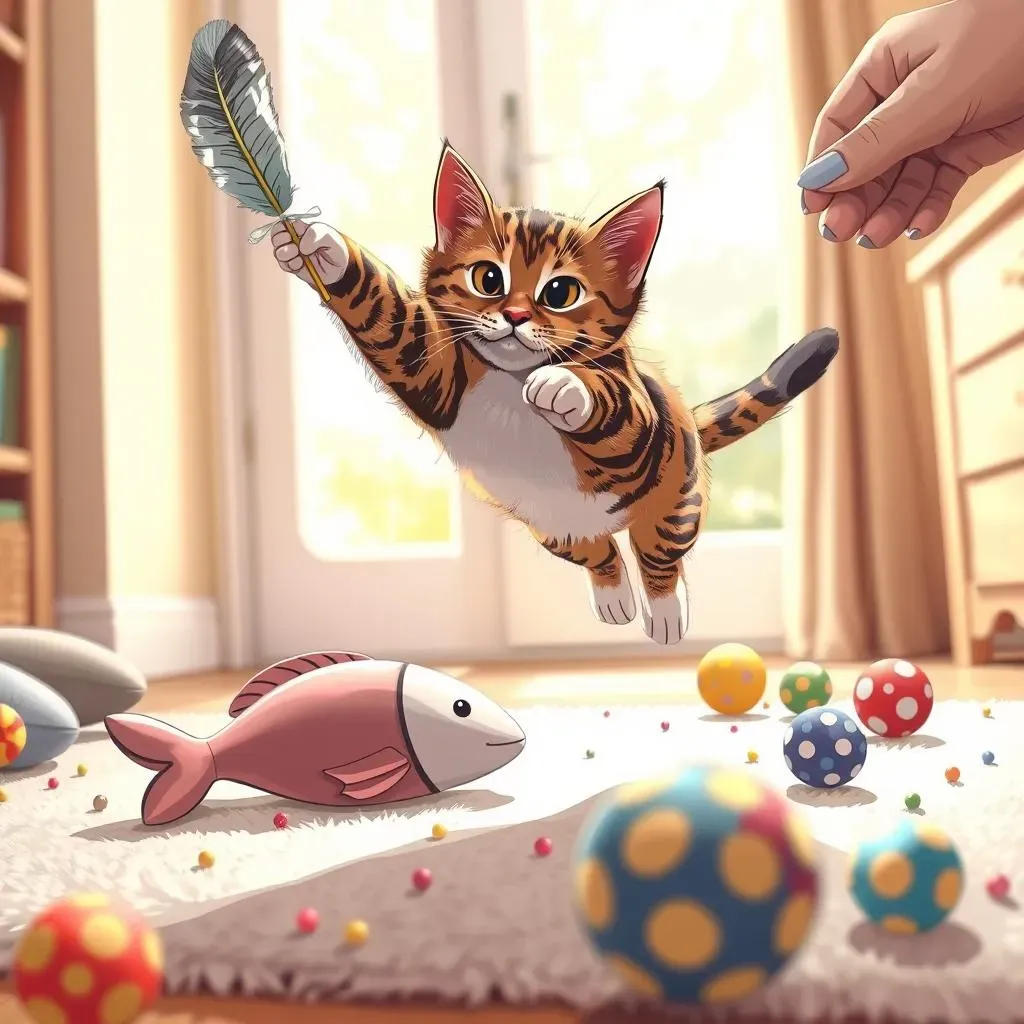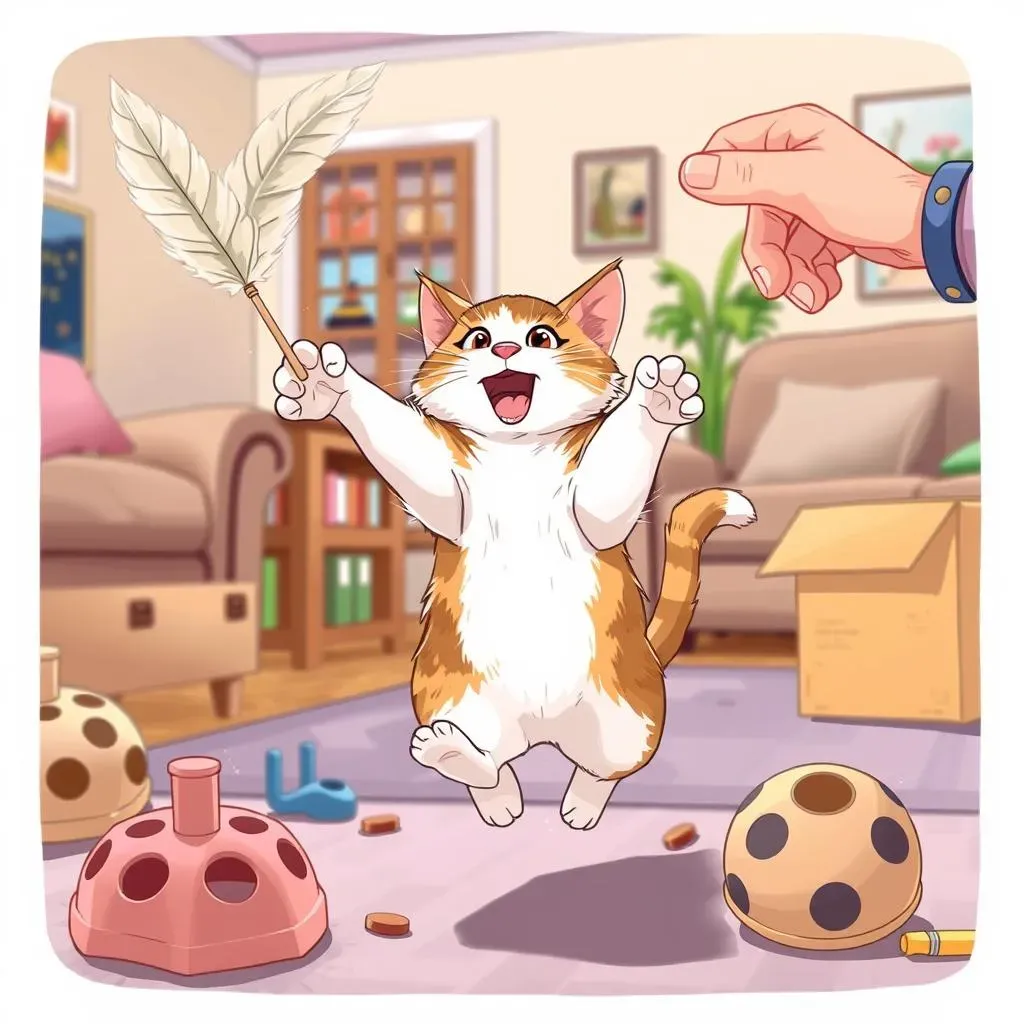Table of Contents
Is your indoor cat bored, spending most of the day napping? It's a common problem! Just like us, cats need mental and physical stimulation to thrive. That's where the best cat toys indoor cats come in. Toys aren't just about fun and games; they're essential for your feline friend's well-being, helping them satisfy their natural instincts, get exercise, and prevent boredom. A bored cat can become a destructive cat, so investing in the right toys can save your furniture and your sanity. In this guide, we'll explore why indoor cats need toys, the different types available to cater to their unique play styles, and how to choose the perfect toys for every life stage. Plus, we'll share some tips and tricks to encourage play, turning your living room into a feline playground. Get ready to discover the keys to a happier, healthier, and more playful indoor cat!
Why Indoor Cats Need the Best Toys: Enrichment and Exercise

Why Indoor Cats Need the Best Toys: Enrichment and Exercise
The Indoor Cat Predicament
Let's face it, our indoor cats don't exactly live in the wild. They're safe, warm, and well-fed, but that also means they're missing out on the natural challenges and stimulation that their outdoor counterparts experience. Think about it: hunting for food, exploring new territories, and interacting with other animals. Without these outlets, indoor cats can become bored, stressed, and even depressed. That's where the best cat toys come in, transforming your home into an engaging environment that caters to their natural instincts.
Ever notice your cat 'attacking' your feet under the covers? Or maybe they stalk dust bunnies with the intensity of a lion hunting a gazelle? These are signs that their hunting instincts are kicking in, and they need a way to express them. Toys provide that crucial outlet, allowing them to stalk, chase, pounce, and capture, all within the safety of your home.
Mental Stimulation: Keeping Their Minds Sharp
It's not just about physical activity; cats need mental stimulation too! A bored cat is more likely to develop behavioral problems like excessive scratching, destructive chewing, and even aggression. Toys that challenge their problem-solving skills, like puzzle feeders and interactive games, can help keep their minds sharp and engaged. Think of it as giving their brains a workout, preventing cognitive decline and keeping them entertained for hours.
I know one cat, Whiskers, who used to tear up the furniture when his owner was at work. After introducing puzzle feeders and rotating his toys regularly, the destructive behavior completely stopped. He was simply bored and needed something to occupy his clever little mind. That's the power of mental enrichment!
Exercise in Disguise: Combating the Sedentary Lifestyle
Indoor cats are prone to obesity due to their relatively inactive lifestyles. Unlike outdoor cats who roam and hunt, indoor cats often spend most of their time sleeping and grooming. Regular play sessions with the best cat toys for indoor cats can help them burn calories, maintain a healthy weight, and improve their overall physical condition. It's a fun and effective way to combat the sedentary lifestyle and keep them in tip-top shape.
Think of interactive toys like laser pointers or feather wands as your cat's personal trainers. They encourage them to run, jump, and pounce, providing a full-body workout without them even realizing they're exercising. Plus, it's a great bonding experience for you and your feline friend!
Benefits of Exercise for Indoor Cats:
- Weight management
- Improved cardiovascular health
- Stronger muscles and bones
- Reduced risk of diabetes
- Better sleep quality
Hunting, Kicking, and Brain Games: Exploring Different Types of Cat Toys for Indoor Play

Hunting, Kicking, and Brain Games: Exploring Different Types of Cat Toys for Indoor Play
Hunting Instincts: Toys That Bring Out the Predator
Let's tap into that inner tiger! For most cats, the thrill of the hunt is strong. Toys that mimic prey are ideal for channeling this instinct. Think feather wands, laser pointers, and even those little battery-operated mice that scurry across the floor. The key is to create unpredictable movements that pique their interest and encourage them to stalk, chase, and pounce. Remember to let them "catch" the prey occasionally to avoid frustration! I had a cat named Shadow who was obsessed with a simple feather wand. He would stalk it for hours, his eyes laser-focused, before finally launching his attack. It was amazing to watch him unleash his inner predator.
Mylar crinkle balls are also great for activating hunting instincts. The sound and unpredictable movement mimic the rustling of prey in the underbrush. Toss one down a hallway and watch your cat transform into a stealthy hunter, creeping and crawling before finally pouncing on their "kill." Just be sure to supervise playtime to prevent them from swallowing any small pieces.
Kicker Toys: Unleashing the Pent-Up Energy
Some cats prefer a more physical approach to playtime. Kicker toys are designed for wrestling, biting, and bunny-kicking – a favorite move where they grab the toy with their front paws and kick it with their hind legs. These toys are usually long and plush, providing a satisfying target for their pent-up energy. Look for ones filled with catnip for an extra dose of excitement! My friend's cat, aptly named "Chaos," is a master of the bunny-kick. He has a special kicker toy that he drags around the house, attacking it with gusto whenever the mood strikes.
When choosing a kicker toy, make sure it's durable and can withstand some serious abuse. Look for reinforced stitching and non-toxic materials. You can also try making your own kicker toy by stuffing an old sock with catnip and securely tying off the end. It's a cheap and easy way to provide your cat with hours of entertainment.
Kittens to Seniors: Choosing AgeAppropriate Best Cat Toys for Indoor Cats

Kittens to Seniors: Choosing AgeAppropriate Best Cat Toys for Indoor Cats
Kitten-Proofing Playtime: Safety First!
Kittens are bundles of energy, but they're also delicate and curious, meaning safety is paramount when choosing their toys. Avoid anything with small, detachable parts that could be swallowed, like bells, ribbons, or plastic eyes. Opt for soft, lightweight toys that are easy for them to bat around and carry. Teaser wands with soft feathers or fabric strips are great for encouraging interactive play, but always supervise them to prevent them from chewing on the wand itself. Remember, kittens are still learning, and their play style can be quite… enthusiastic.
Think about the size of the toy too. Something too big could be overwhelming, while something too small could be a choking hazard. I always recommend starting with a few simple, safe toys and observing how your kitten interacts with them. This will give you a better idea of their preferences and help you choose appropriate toys as they grow.
Adult Cats: Catering to Their Unique Preferences
Adult cats have developed their own distinct personalities and play styles, so it's important to choose toys that cater to their individual preferences. Some cats love to chase and pounce, while others prefer to wrestle and bunny-kick. Observe your cat's behavior and experiment with different types of toys to see what they enjoy the most. Puzzle feeders are also a great option for adult cats, providing mental stimulation and slowing down their eating habits. I had a cat who was obsessed with a particular type of crinkle ball. He would carry it around the house, batting it and chasing it for hours. It was his absolute favorite toy, and it kept him entertained and active.
Don't be afraid to rotate your cat's toys regularly to keep things interesting. Cats can get bored with the same old toys, so introducing new ones or simply rearranging the existing ones can reignite their interest. You can also try hiding toys around the house for them to "discover," turning playtime into a fun scavenger hunt. And remember, even a simple cardboard box can provide hours of entertainment for a curious cat!
Life Stage | Recommended Toy Types | Safety Considerations |
|---|---|---|
Kittens | Soft toys, teaser wands (supervised), small balls | Avoid small parts, lightweight materials |
Adult Cats | Variety of toys based on preference (hunting, kicking, puzzle feeders) | Durable materials, rotate toys regularly |
Senior Cats | Soft toys, gentle teaser wands, low-impact activities | Easy to grip, avoid strenuous activities |
Senior Cats: Gentle Play for Comfort and Enrichment
Senior cats may not be as energetic as their younger counterparts, but they still need playtime to stay mentally and physically stimulated. Choose toys that are soft, lightweight, and easy for them to grip. Gentle teaser wands are a great option, allowing them to engage in a low-impact version of their favorite hunting game. Avoid toys that require a lot of jumping or running, as these could put stress on their joints. My elderly cat, Mr. Whiskers, loved a soft, plush mouse that he would carry around and cuddle with. It provided him with comfort and a sense of security, and it was a gentle way for him to stay active.
Also, consider their vision and hearing. Toys with bright colors and interesting textures can be easier for them to see and feel. You can also try toys that make gentle sounds, like crinkling or rattling, to capture their attention. The key is to be patient and understanding, and to adapt playtime to their individual needs and abilities. Even a few minutes of gentle play each day can make a big difference in their overall well-being.
How to Encourage Play with Indoor Cats: Tips and Tricks for Engaging Your Feline

How to Encourage Play with Indoor Cats: Tips and Tricks for Engaging Your Feline
Short and Sweet: The Key to Successful Play Sessions
Cats have notoriously short attention spans, so long, drawn-out play sessions are unlikely to be successful. Instead, aim for short, frequent bursts of activity, lasting just 5-10 minutes at a time. These mini-play sessions are more likely to keep their attention and prevent them from getting bored or overwhelmed. Think of it like a quick workout, rather than a marathon. I find that squeezing in a few play sessions throughout the day, especially before meals, is a great way to keep my cats happy and active. It also helps to tire them out before bedtime, leading to a more peaceful night for everyone!
Pay attention to your cat's body language. If they start to lose interest, wander off, or become aggressive, it's time to end the session. Don't force them to play if they're not in the mood. You can always try again later. Remember, playtime should be a fun and positive experience for both of you!
Variety is the Spice of Life: Introducing Different Types of Toys
Just like us, cats can get bored with the same old routine. That's why it's important to offer a variety of toys to keep them engaged and stimulated. Rotate their toys regularly, hiding some away and bringing out new ones to keep things interesting. You can also try introducing different types of toys that cater to their different instincts, like hunting, kicking, and problem-solving. For example, one day you might use a feather wand to mimic prey, and the next day you might introduce a puzzle feeder to challenge their minds. The key is to keep them guessing and prevent them from getting bored.
I've found that having a "toy box" with a selection of different toys is a great way to keep things fresh. Every few days, I'll swap out a few toys for others, and it's like Christmas morning all over again for my cats! They get so excited to see what new treasures await them. You can also try making your own toys using household items like cardboard boxes, toilet paper rolls, and old socks. Get creative and have fun with it!
Tip | Description |
|---|---|
Short Sessions | Aim for 5-10 minute play sessions |
Toy Rotation | Regularly swap out toys to prevent boredom |
Variety | Offer different types of toys to cater to different instincts |
Positive Reinforcement | Reward play with praise and treats |
Demonstrate the Fun: Show Them How to Play
Sometimes, cats need a little encouragement to get started. Don't just toss a toy at them and expect them to know what to do. Instead, demonstrate how to play with it. Wiggle a feather wand enticingly, roll a ball across the floor, or show them how to manipulate a puzzle feeder. Once they see how much fun it can be, they're more likely to join in. I've found that even the laziest cats can be enticed to play with a little bit of encouragement. It's all about sparking their curiosity and showing them the possibilities.
Use positive reinforcement to reward their efforts. Praise them when they chase, pounce, or solve a puzzle. You can also offer them a small treat as a reward. This will help them associate playtime with positive experiences and make them more likely to participate in the future. And remember, patience is key. Some cats may take longer to warm up to playtime than others. Just keep trying, and eventually, they'll come around.
Conclusion: Unleashing Playtime with the Best Cat Toys for Indoor Cats
Finding the best cat toys for indoor cats doesn't have to be a chore. By understanding your cat's individual play style, considering their age and physical abilities, and experimenting with different types of toys, you can create an enriching environment that keeps them happy, healthy, and entertained. Remember, playtime is more than just fun; it's a crucial part of your cat's overall well-being. So, ditch the boredom, embrace the play, and watch your indoor cat thrive with the purr-fect selection of toys!